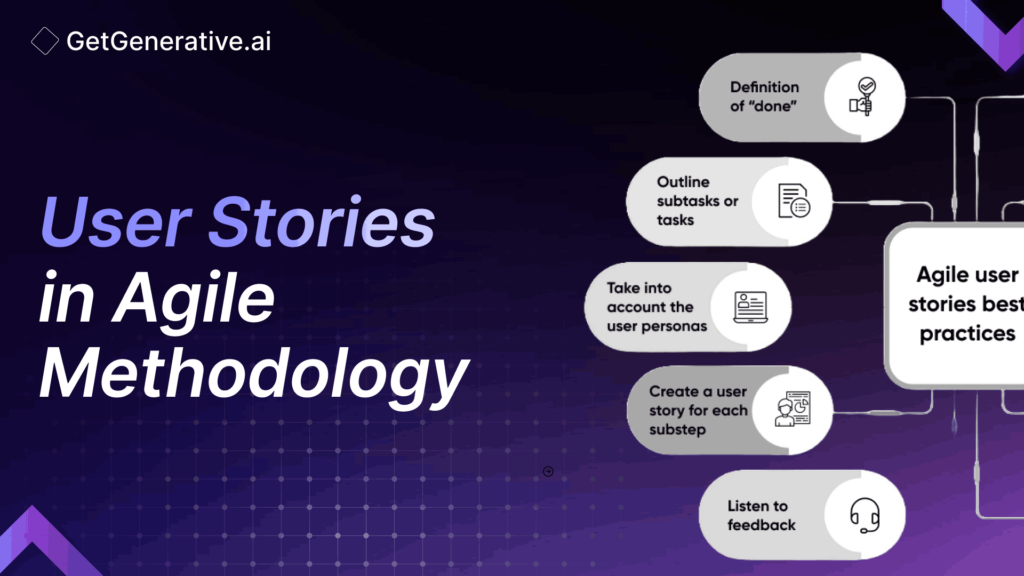User Stories in Agile Methodology
User narratives play a role, in the approach by offering concise and transparent explanations of a feature or capability from the users or customers’ perspective, but why are user stories essential, in Agile development?
Let’s take a look at user stories in this piece as we delve into their elements and structures while also uncovering the advantages they bring to development practices.
What are user stories in the context of methodology?
A user story essentially is a description outlining a feature or improvement needed by the end user from their perspective to ensure the development team fully understands their requirements and the motivations behind them.
“As someone using this service, I require an outcome in order to achieve an objective.”
This basic structure guarantees that every member of the team stays on the page and comprehends the users requirements clearly.
Introduction to Agile Methodology
The Agile methodology follows a step-by-step process for software development that’s iterative in nature rather than working in long phases like traditional methods do. So, instead of working for lengthy periods, Agile teams break down the work into parts known as “Sprints,” which usually last between two to four weeks and are aimed at accomplishing specific user stories. Agile emphasizes adaptability, collaboration and feedback, from customers making it well suited for industries that undergo rapid changes.
Why User Stories Matter in Agile Development
User stories are central to Agile methodology as they connect the customer’s requirements with the development process, ensuring that both align effectively. They make it easier for teams to prioritize features, understand what needs to be built, and provide regular updates to stakeholders. User stories encourage collaboration between developers, designers, and product managers, fostering an environment where everyone works towards a common goal.
Components of a User Story
Key Elements of a User Story
A good user story typically consists of three key components:
- The User: Who is the feature for? Is it for an end-user, administrator, or developer?
- The Goal: What functionality or feature is needed?
- The Benefit: Why does the user need this feature? How will it benefit them?
These components together provide the necessary context for the development team to understand what needs to be done and why it’s important.
The Three C’s of User Stories:
- Card: User stories are often jotted down on index cards as a simple way to document them.
- Conversation: The card is just a placeholder for discussions. The conversation between the team and stakeholders is the most crucial aspect of a user story. This dialogue ensures that the story is fully understood and can be implemented effectively.
- Confirmation: Finally, the confirmation ensures that the story meets the agreed-upon acceptance criteria, meaning the feature or functionality works as expected.
Also Read – How Agile Methodology Works: A Beginner’s Guide to Efficiency
Writing Effective User Stories
Creating user stories that clearly communicate the user’s needs and are actionable for the development team is crucial in Agile. Here’s a breakdown of specific steps to ensure your user stories are effective and lead to successful outcomes:
1. Understand the User’s Perspective
Before crafting a user story, it’s essential to understand who the user is and what problem they are trying to solve. This ensures the story remains user-focused rather than feature-focused. For instance, instead of writing “Create a login feature,” it’s more effective to frame it as:
Example:
“As a first-time user, I need to register so that I can access customized services.”
This approach keeps the focus on user benefits and helps the development team grasp the reasoning behind the request.
2. Use the Standard User Story Format
The most common and effective format for user stories is:
“As a [user], I want [goal] so that [reason].”
This structure keeps things clear and concise while ensuring that the user story includes three key elements:
- The User: Who the story is about.
- The Goal: What the user wants to achieve.
- The Reason: Why this goal matters to the user.
For example: “As an admin, I want to filter user data so that I can generate customized reports more easily.”
3. Keep It Small and Actionable
User stories should be concise enough to be finished within one sprint. If a user story is too large or complex, it’s important to break it down into smaller, more manageable segments to ensure smooth implementation. This approach ensures the story stays focused and can be completed efficiently within a shorter timeframe. For example:
Instead of: “As a user, I want to manage my entire account from the dashboard.”
Break larger stories into more specific ones, such as:
- “As a user, I need to update my profile details.”
- “As a user, I need to reset my password.”
Each smaller story becomes more focused and easier to manage within a sprint.
4. Include Clear Acceptance Criteria
Acceptance criteria define the requirements that must be fulfilled for a user story to be considered complete. Without clear criteria, it’s easy for the development team to miss important details or misinterpret the user’s needs. Well-defined acceptance criteria help eliminate ambiguity and ensure everyone understands when the story is “done.”
For example, acceptance criteria for a login feature might include:
- The user must log in with their username and password.
- An error message should display for incorrect credentials.
- Upon successful login, the user should be directed to their homepage.
5. Team Collaboration
User stories are dynamic tools for collaboration. Once a story is written, the team should engage in a discussion to clarify details, raise questions, and ensure everyone understands the requirements. In Agile, communication is key, and regular team discussions around user stories are essential to avoid misunderstandings.
6. Focus on Value, Not Technical Details
A frequent mistake is to include excessive technical details in user stories. Instead, focus on the value to the user. The technical aspects can be determined during implementation. For example, rather than stating:
“As a developer, I need to implement a data system using MySQL,”
write:
“As a user, I need to save my data securely so that I can retrieve it later.”
The user story is now focused on the user’s need, leaving the technical decisions to the development team.
7. Prioritize Based on User Value
Not all user stories are created equal. To ensure the highest priority features are developed first, prioritize user stories based on their value to the user or business. Stories that deliver more significant value should be worked on first. Agile uses the product backlog to organize and prioritize user stories, helping the team stay focused on what’s most important.
Also Read – Types of Agile Methodologies: Principles and Applications
User Story Formats
Standard User Story Template
A standard user story format is simple: “As a [user], I want [goal] so that [reason].”
For example:
“As a customer, I want to track my order so that I can know when it will arrive.”
This format maintains a user-centered focus, ensuring the development team understands the requirement from the user’s perspective.
User Stories vs. Use Cases
While both user stories and use cases describe functionality, they serve different purposes. Use cases are more detailed, often describing every interaction step-by-step. User stories are designed to focus on what needs to be accomplished rather than the specific steps on how it should be done, keeping the process high-level and flexible.
Summing Up
User stories are crucial to the success of Agile development, providing a clear framework that keeps teams focused on delivering user-centric value. They ensure that development teams prioritize features that bring real value to the end-user.
To learn more, visit GetGenerative.ai today!
FAQs
1. What is a user story in Agile?
In Agile, a user story is a concise, clear explanation of a feature or function from the user’s viewpoint, aimed at conveying their specific needs to the development team.
2. Why are user stories important?
User stories help teams focus on user needs, ensuring the product delivers real value and prioritizing work efficiently.
3. How are user stories different from use cases?
User stories are high-level, focusing on what needs to be done, while use cases provide step-by-step details on how functionality should work.
4. What are the three components of a user story?
The three key components are the user, the goal, and the benefit.
5. How can I write better user stories?
Focus on clarity, keep it simple, collaborate with your team, and always think from the user’s perspective.




